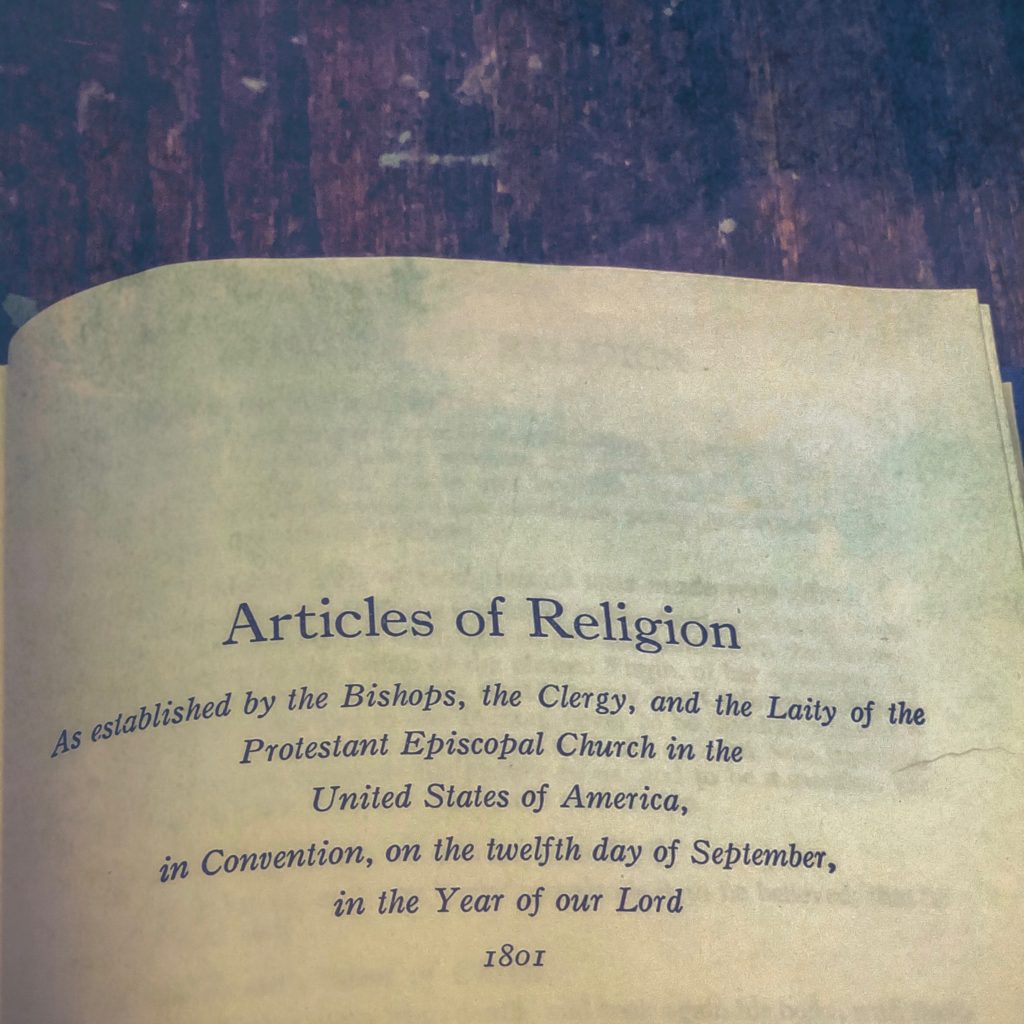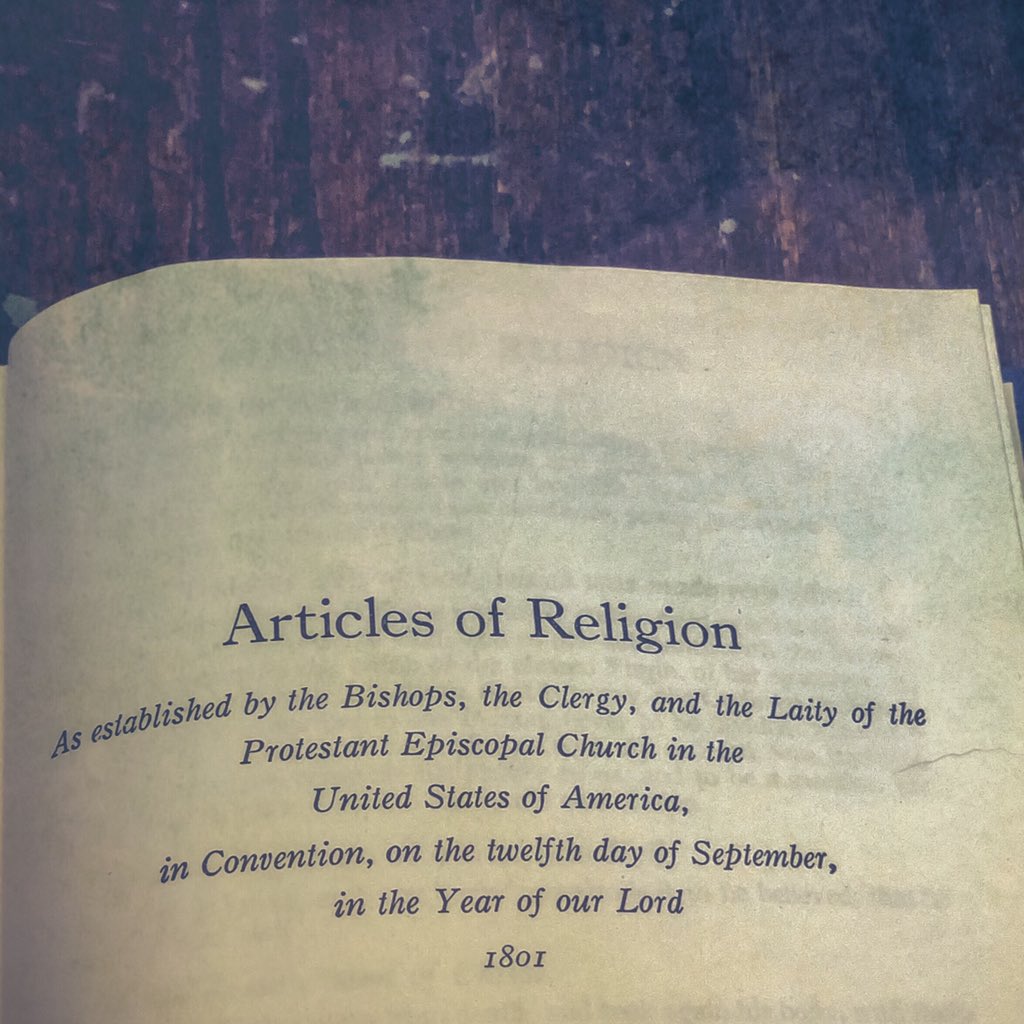
Original sin standeth not in the following of Adam, (as the Pelagians do vainly talk;) but it is the fault and corruption of the Nature of every man, that naturally is engendered of the offspring of Adam; whereby man is very far gone from original righteousness, and is of his own nature inclined to evil, so that the flesh lusteth always contrary to the Spirit; and therefore in every person born into this world, it deserveth God’s wrath and damnation. And this infection of nature doth remain, yea in them that are regenerated; whereby the lust of the flesh, called in Greek, φρονημα σαρκος, (which some do expound the wisdom, some sensuality, some the affection, some the desire, of the flesh), is not subject to the Law of God. And although there is no condemnation for them that believe and are baptized; yet the Apostle doth confess, that concupiscence and lust hath of itself the nature of sin.
by M. L. Harrison
Article IX understands one thing very well: that for a brand that all of us bear, original sin sure has a branding problem. One is, ironically, the strength of its current brand, iconic as the Apple logo: most popular discussions of original sin focus so much on the expulsion myth of Adam and Eve that it’s difficult to understand what the term original sin could possibly mean in any later context. Another problem with original sin’s “brand” is quite different, however, and if anything more troubling: the multiplicity of disparate things that get labeled “original sin” without reference to an underlying theology. Searching online news pieces for “[Name of Politician]’s original sin was,” my results include jurisprudential opinions, military action, legislative inaction, decisions about the economy, understandings of international relations, and racism (the politician’s or others’, depending).
Taken in aggregate, each of the “original sins” metaphorically evoked by journalists or pundits begins to hew to similar and very familiar contours: the label usually adheres to a moment of weakness (often motivated by prideful impercipience) out of which innumerable successive evils have ensued. Sometimes, as the examples above would show, the “original sin” is envisioned as a personality trait. We are accustomed to think or speak about literary characters in this way—“original sin” as analogue to hamartia—such that we might assert that Pandora’s was simply curiosity. At other times, “original sin” is construed as an action (Pandora choosing to open her eponymous box): explanations of original sin meant for children often move in this direction, making the key aspect of the story of Adam and Eve the first parents’ act of biting the forbidden fruit. Either way—letting a personality trait or an action be at fault—the popular understanding of original sin invoked by news pieces lets literary considerations overshadow what the Thirty-Nine Articles of Religion represent to be the truth: that so far from being some trait or action unfortunate in degree or in certain unforeseeable circumstances, original sin is actually something innate and irreducibly bad.
Before getting to Article IX’s more specific definition of what, exactly, original sin is, a troubling question presents itself: what’s so dangerous about understanding original sin as we typically do? No one denies that human existence is rife with tragic ironies. No one denies that people have made and will always make mistakes. The risk of maintaining our understanding of the central problem in such terms, however, might be an encouragement to pride: a misconception that humans don’t really have any innate flaws; that Christians are simply caught in a strangely self-defeating myth they use to feel down about themselves. It is into just this welter of confusion that Article IX bravely steps, asserting that the problem of original sin “standeth not in the following of Adam (as the Pelagians do vainly talk)” but is in the lineage of Adam, the “fault and corruption of the Nature of every man.” Article IX seems to insist, in other words, that original sin is not a matter of action but of being, not a matter of personality but of essence.
⁂
What use, one might wonder, to criticize humans for some way that they are? What could improvement look like? The answers to those questions were a matter of extensive speculation by some of the leading figures of monasticism, particularly following the revival of interest in the monastic life that accompanied and followed the tenth-century Benedictine Reforms. The Psalmist notes that humans were created only “a little lower than the angels,” after all; and if the difference between the ontology of angels and humans is the lack of some form of sin inherent to humanity—if we consider sin in fact to be part of human nature—then an embrace of “the angelic life” was also an experiment in attempting to escape the problems that original sin seemed to pose. For thinkers such as Anselm, “angelic life” was less an interesting way to try to live one’s religious aspirations so much as it was a solemn and urgent calling. It was thought that God’s original motive for creating humans was to fill a gap in the celestial hierarchy (forever circling the throne of the godhead) after the fall of Satan and his rebel angels. Humans, endowed with free will, would be able to choose their obedience and thereby fully and more completely merit a place of prominence in the heavenly host. Obedience, a cornerstone of cenobitic life given a place of great prominence in the Rule of St. Benedict, was among other things a powerful and ostensibly effective way of mitigating the dangerous implications of free will.
The other obvious difference that ascetic reformers saw between angels and humans—corporeality—posed a trickier problem; if the Scholastics had posed an open question about how many angels can dance on the head of a pin, the answer for how many humans can do so has always been zero. And yet the physical world, as in the “three foes” formulation of “the world, the flesh, and the devil,” was bad in part for its base physicality: its very matter. No one disputed the inevitability of embodiment, of course, which in the language of Article IX affects “every person born into this world.” To the extent that “the world” was also overlaid by centuries of human relationships and human culture, however, it could at least partially be escaped. For just as Jesus went to the desert to pray and was waited on there by angels, inspiring early hermits and the inchoate communities started by the so-called Desert Fathers, the fuga sæculi enacted through literal retreat to the desert came to be associated with a sort of paradise. Later, far removed from the actual deserts of North Africa and Palestine as they were, the cenobitic houses of high-medieval Europe embraced this flight through allegory. That symbolic and abstracted understanding enabled them to see the rarified and restrained environment within their monastery walls as an echo of that desolate yet holy place: the paradisus claustralis or “paradise of the cloister.”
The foregoing snapshot of intellectual and institutional history isn’t actually addressed by the authors of the Thirty-Nine Articles, if it was ever really known. Yet a certain poignant irony attends the idea that at best a stylized paradise, ruled by little more than the unchanging rhythm of the canonical hours, was in a significant context and for a fairly long time the closest not a few humans felt they could come to the impassive state enjoyed by the parents of humanity—and that irony grows only greater when one considers that the pangs heralding the birth of Anglicanism included Henry VIII’s infamous Dissolution of the Monasteries (truly, as the collect puts it, “we have no power in ourselves to help ourselves”). Indeed, decrying the near-Pelagianism of any efforts to avoid original sin, the text of Article IX instead rings changes on the word “nature,” emphasizing the problem as not only embedded in the matrix of reality but transmitted like a plague, an “infection of nature.” Some version of the word “nature” appears a total of five times in Article IX, in fact, with the more memorable “lust” appearing only three times. If they might not have approved of the proposed solution, then, the authors of Article IX seem tacitly to agree with earlier precedent (monastic or otherwise) in locating the majority of the problem of original sin with our rootedness in the physical world. Perhaps it is for this reason that the Article concludes by noting that original sin “hath of itself the nature” of sin properly so called, because unlike other sins it cannot be chosen. Who chooses to be born?
But, again, embodiment is just one facet of the problem identified by early Christians. Regarding the other major facet, free will, we learn from the Article that “the flesh lusteth always contrary to the Spirit,” never “subject to the law of God.” And although it is often dangerous to apply contemporary English semantics to Early Modern words, one’s first impression here is that the flesh takes an active pleasure in resisting the wishes of the mind. How might we better characterize this resistance? A cascade of near synonyms depending from a single phrase rendered in Greek as phronema sarkos reveals the difficulty of the question and the authors’ attempts to specify it: we learn that “some do expound” the term as the body’s “wisdom,” its “sensuality,” its “affection,” or its “desire,” the connotations for each translation moving (from first to fourth) across a spectrum whose poles might be the passive rationale of a plant at the one end and the active intelligence of a conscious animal at the other. In reality, of course—as science has helped to show—all of these senses could be said to obtain for the impulses of the body, giving a range analogous to the continuum of ways that scripture describes the nature of spirit (from wind to breath to Comforter and groaning intercessor, the last two particularly describing the third person of the Trinity). The Article’s cautiously capacious approach to characterizing the body’s ongoing resistance to spirit—is it an obstacle like a stone in the path of a plow, or is it simply wicked?—informs the use of Greek, which use at once places original sin in the realm of philosophical conundrums and also (or at least by the time the Episcopal Church adopted it) was used in schools to hide material “for mature audiences only” from pupils already versed in Latin: a figleaf (as it were) over sexual desire.
As I’ve attempted to sketch above, original sin has long been understood as something that partakes of biology but cannot be reduced to it. Similarly, we have seen, it is a problem with a philosophical nature that cannot be dismissed as a mere intellectual curiosity. It is a core principle throughout, not a strange detour from, the history of Christian thought. That having been said, it may sound somewhat chilling when Article IX intones that original sin merits God’s “wrath and damnation”; if monasticism’s embrace of the “angelic life” missed the mark a little for not being universally applicable, it was at least a response to the problem put forward in good faith. For the rest of us, there is the renewal of nature provided through the sacraments, since “there is no condemnation for them that believe and are baptized.” But even then, “yea in them that are regenerated,” the experience if not the sentence (of damnation!) stubbornly remains.
⁂
Some members of today’s clergy, faced with the daunting pastoral task of acknowledging original sin as a problem that no one merits yet that everyone seems unable to escape, have urged Christians to shift their consciousness of original sin to that of humans’ “original blessing” instead. God made the world and called it good, they might note; for that matter, medieval theologians similarly leavened their dark views regarding “the world” with a concomitant notion of the inherent “dignity of man.” We can commend this approach if it could help to wean our denominational culture away from a fear-driven insistence on early infant baptism to which some might still cling; it is hard to imagine Jesus of Nazareth holding with the idea that deceased unbaptized infants occupy a quasi-limbo, let alone the hell that “damnation” for the unbaptized would appear to merit. At the same time, by alluding to the Apostle Paul’s testimony (e.g. Romans 7:15), Article IX makes a plain case for the attendant confusion and despair when original sin is left unexamined—unlike the “thorn in the flesh” the same apostle refers to in 2 Corinthians 12—through the lens of faith. As 2 Corinthians 12:10 in particular suggests, a right appreciation of original sin leads to a right appreciation of the limits of human nature. Far from an impediment to human flourishing, then, it deserves to be a major focus of ongoing spiritual formation that only begins with baptism.
M.L. Harrison hails originally from Southern Virginia and received a Ph.D. in medieval studies in 2010 from Cornell University. He lives, works, worships, writes, and teaches in and around the District of Columbia. His writing can be found at retracery.wordpress.com.

